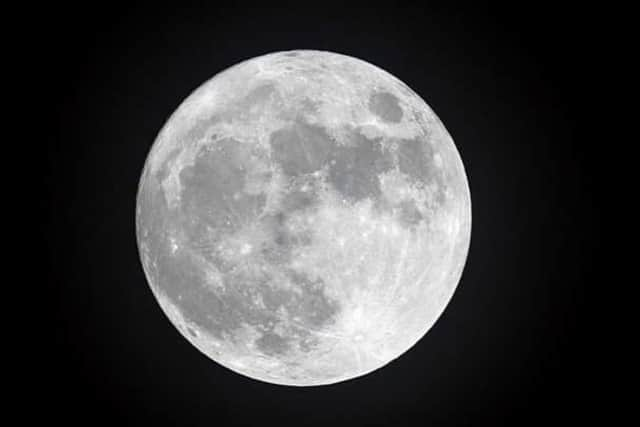July Full Moon Glasgow 2023: When will the Buck Moon appear and will it be a supermoon?
and live on Freeview channel 276
July is here, and with it comes a new full moon. Stargazers across Glasgow will take extra care when preparing to catch a glimpse of this full moon as it will be the first super moon of 2023.
This full moon is known as the ‘Buck Moon’, and will be the seventh full moon of the year. The Moon appears as different shapes in the sky depending on its ‘phase’, from new Moon to full Moon via ‘waxing’ (growing) and ‘waning’ (shrinking) moons. These phases are determined by the relative positions of the Sun, Earth and Moon.
Advertisement
Hide AdAdvertisement
Hide AdRoyal Museums Greenwich explains where the anime Buck Moon comes from. They say: “Male deer, which shed their antlers every year, begin to regrow them in July, hence the Native American name for July’s full moon. Some refer to this moon as the thunder moon, due to the summer storms in this month. Other names include the hay moon, after the July hay harvest.”
So, when will you be able to see the Buck Moon? Here’s everything you need to know about the celestial event in Glasgow.
Will the Buck Moon be a supermoon?
This year’s Buck Moon will be extra special as it will be the first supermoon of 2023. Royal Museums Greenwich explains how a supermoon comes to be, saying: “the distance between the Moon and the Earth varies, because the Earth is not right at the centre of the Moon’s orbit and the Moon’s orbit is not a circle (it’s an ellipse). The moment when the Moon is closest to the Earth is called a lunar perigee.
“When the Moon is furthest away it is known as a lunar apogee. If the lunar perigee occurs very close to a full moon, then we see a supermoon. If a lunar apogee occurs very close to a full moon then we see a micromoon.”
Will the supermoon be visible in Glasgow?
Advertisement
Hide AdAdvertisement
Hide AdDue to the nature of the supermoon, stargazers across the city of Edinburgh will be in with an even better chance of seeing it. Conditions are expected to be cloudy so you may need to wait for clouds to pass to catch a glimpse but it will be worth the wait.
Top Stargazing Tips
Stargazing is easy, you just go outside and look up at the night sky, but to get the most spectacular views, there are a few rules you should follow. The best tip is finding a dark-sky site, and checking the weather forecast before going. Light pollution can often affect how much of the night sky occurrences we see, even more so, cloudy weather conditions make it more difficult to see the stars beyond.


If you are unable to get to a designated dark-sky site, find the least illuminated spot you can where you can see the horizon. Stargazing is such a popular hobby for amateurs and professionals alike, it’s likely there is a club near you, or you may have friends with a similar interest. Finding a buddy or club to join on the cold dark nights is always helpful, and one of the best ways to stay safe when stargazing.
When is the next full moon?
The next full moon on July 3 will peak at 12.38pm in the UK, and is sometimes known as a ‘Buck Moon’. The Old Farmer’s Almanac said there will be 13 full moons throughout the year. These are listed below.
- January 6: Wolf moon
- February 5: Snow moon
- March 7: Worm moon
- April 6: Pink moon
- May 5: Flower moon
- June 3: Strawberry moon
- July 3: Buck moon
- August 1: Sturgeon moon
- August 30: Blue moon
- September 29: Harvest moon
- October 28: Hunter’s moon
- November 27: Beaver moon
- December 26: Cold moon
Comment Guidelines
National World encourages reader discussion on our stories. User feedback, insights and back-and-forth exchanges add a rich layer of context to reporting. Please review our Community Guidelines before commenting.
